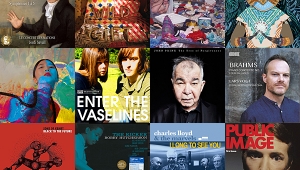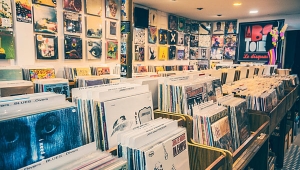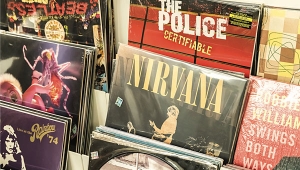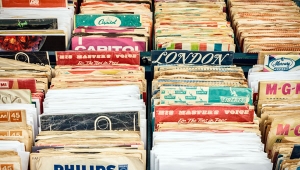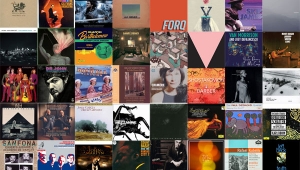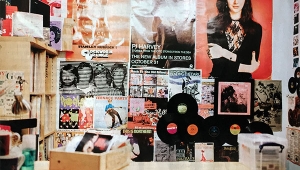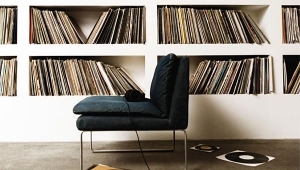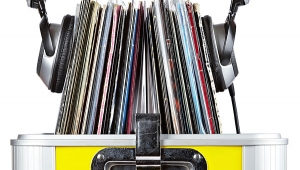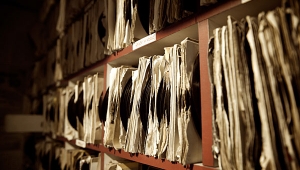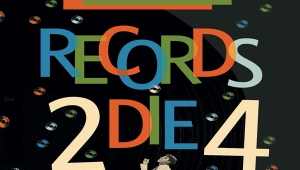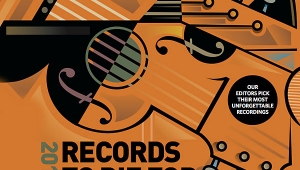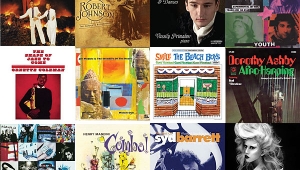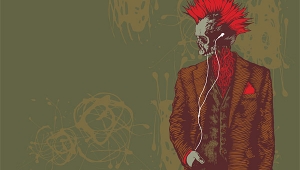| Columns Retired Columns & Blogs |
1991 Records To Die For Page 4
Kevin Conklin
BEETHOVEN: Symphony 3
Lovro von Matacic
Quintessence PMC-7089 (LP). Miloslav Kulhan, eng.; Miloslav Kuba, prod. AAA.
Not at all an eccentric performance, just an excellent one, which a Gramophone reviewer rightly compared to Weingartner's. Playing is fleet and graceful. Centerpiece of the performance is a lacerating funeral march, as concentrated a stretch of music as the underrated Matacic ever recorded.
BRUCKNER: Symphony 9
Bruno Walter, Columbia SO
CBS/Sony 20AC 1829 (LP). John McClure, prod. ADA.
This choice stands for the best of Walter's late recordings, made in California by Columbia when that label still produced rich, vivid orchestral sounds. Criticism has been leveled at these readings, alleging a lack of the ample spirituality that imbues Walter's European recordings. The Bruckner nullifies this criticism: here is devotional intensity rarely heard since Knappertsbusch and Furtwängler, reflecting Walter's conviction that music has moral force. The conductor, approaching his own death, encounters anew Bruckner's last testament.
JOHN COLTRANE: A Love Supreme
John Coltrane, tenor sax; McCoy Tyner, piano; Elvin Jones, drums; Jimmy Garrison, bass
MCA/Impulse 29017 (LP). Bob Thiele, prod. AAA.
A performance of ecstatic devotion, this revolutionary Black classical music is Coltrane's grand statement of faith, reflecting his Christian roots and influence by Eastern cultures. Despite its reputation for being so much noise, A Love Supreme speaks surprisingly directly to the listener who allows the music to penetrate. Later records, made after Coltrane completely abandoned A-B song-form, are vastly more difficult.
IVES: Three Places in New England, Symphony 3
Howard Hanson, Eastman-Rochester Orchestra
Mercury SR90149 (LP). C. R. Fine, eng.; Wilma Cozart, Recording Director; Harold Lawrence, Musical Supervisor. AAA.
Two great performances of American symphonic music. The up-close Mercury sound, which sometimes rendered orchestral music strident and hi-fi-ish, works here because of Hanson's attention to line, and his relatively small ensemble. More distant-perspective recordings of Three Places, made with virtuoso orchestras, tend to "civilize" the music, as Aunt Polly tried to do with Huck Finn.
PINK FLOYD: Dark Side of the Moon
Mobile Fidelity UDCD 517 (CD only). Alan Parsons, eng. AAD. TT: 42:58
Much '70s rock music was greater, but none so decisively made its statement with sound. Of course this has nothing to do with any natural aural phenomenon. The audacity of the record is its imaginative construction of a sound-world ex nihilo, and imagination is a quality so lacking nowadays that, where found, it deserves reward.
42ND STREET: Original Broadway Cast
John Lesko, cond.; Harry Warren, music; Al Dubin, lyrics
RCA CBL1-3891 (LP), RCD1-3891 (CD). Paul Goodman, eng.; Thomas Z. Shepard, prod. AAA/AAD. TT: 48:17
The screaming trumpets of the orchestra, the boys and girls of the chorus singing and tap-dancing their hearts out: 42nd Street is show music at its showiest. The cast performs as if they think every number is going to be a showstopper---and most of them are. In either format, the sound is appropriately bright and dynamic, with the LP revealing more subtle detail in the ensembles. Sure, it's multi-miked, but this is New York, buddy. If you don't like it, go back to Allentown.
MAN OF LA MANCHA: Original Broadway Cast
Neil Warner, cond.; Mitch Leigh, music; Joe Darion, lyrics
Kapp KRS-4505 (LP), MCA MCAD-1672 (CD). Michael Kapp, prod. AAA/AAD. TT: 45:51
"I shall impersonate...a man. Come, enter into my imagination and see him." With these words, and the ensuing "I, Don Quixote," Richard Kiley draws us into the quintessential musical-within-a-musical about Cervantes and his literary creation, the estimable Don Q. Kiley gives one of the musical theater's great performances, and the recording fully captures its extravagant theatricality. Joan Diener is right up there (perhaps even over the top) as Aldonza, and Robert Rounseville contributes a beautifully sung Padre. The CD, while very good, is not quite a sonic match for the original Kapp LP, but is superior to the MCA LP reissue.
LES MISERABLES: Original London Cast
Martin Koch, cond.; Claude-Michel Schönberg, music; Herbert Kretzmer, Alain Boublil, Jean-Marc Natel, Trevor Nunn, John Caird, lyrics
REL 88561-8140-2 (2 CDs only). David Hunt, eng.; Alain Boublil, Claude-Michel Schönberg, prods. AAD. TT: 97:24
If I may quote from my review in Vol.11 No.9---and if I can't, who can?---"what we have here is the genuine article: music that is tuneful and theatrically appropriate, lyrics that are at least serviceable, and deeply felt, committed performances." This first English-language recording of Les Miz remains the best of all available versions, both in performance and sonically. Colm Wilkinson is the definitive Valjean, Patti LuPone is heartbreaking as Fantine, and there are fine contributions from Rebecca Caine and Michael Ball. Recording balance tends to favor the voices, but not excessively so. (XI-9)
PUCCINI: La Bohème
Mirella Freni, Mimi; Luciano Pavarotti, Rodolfo; Elizabeth Harwood, Musetta; Rolando Panerai, Marcello; Nicolai Ghiaurov, Colline; Gianni Maffeo, Schaunard; others; chorus of the Deutsche Oper, Berlin; Berlin Philharmonic Orchestra, Herbert von Karajan
London 421 049-1 (2 LPs), -2 (2 CDs). AAA/AAD. TT: 110:00
The tempi are a trifle eccentric, and the analytical tendency borders on fussiness, but von Karajan's approach to this opera does illuminate aspects of the score that remain unexplored in other recordings. The cast is generally first-rate, with Freni a touchingly vulnerable Mimi, and Pavarotti's Rodolfo possibly the best thing in the tenor's extensive recording career. Then there's the sound: glorious '70s analog, featuring realistic vocal/instrumental timbres, a soundstage that's wide and deep, and powerful dynamics.
STRAUSS: Die Fledermaus
Nicolai Gedda, Eisenstein; Anneliese Rothenberger, Roselinde; Renate Holm, Adele; Adolf Dellapozza, Alfred; Dietrich Fischer-Dieskau, Dr. Falke; Brigitte Fassbaender, Prince Orlofsky; Walter Berry, Frank; others; Vienna State Opera Chorus, Vienna Symphony Orchestra, Willi Boskovsky
Angel SBLX-3790 (2 LPs), CDMB-69354 (2 CDs). Christfried Bickenbach, eng.; Helmut Storjohann, prod. AAA/AAD. TT: 1:54:40
This 1972 recording of the world's most popular operetta has a topnotch cast and wonderfully idiomatic playing/conducting from the Vienna Symphony and Willi Boskovsky. The sound is warm, spacious, with excellent depth (listen to the "offstage" voice of Alfred in the first scene). There is one sonic anomaly: the spoken passages seem to be in a completely different acoustic, as if the performers recorded the dialogue in sound booths. Somewhat annoying, but when the music starts, all is forgiven.

Gordon Emerson
DAVID DIAMOND: Symphonies 2 and 4, Concerto for Small Orchestra
Gerard Schwarz, Seattle Symphony, New York Chamber Symphony
Delos DE 3093 (CD only). John Eargle, eng.; Amelia S. Haygood, prod. DDD. TT: 73:01
Although much closer in spirit to the romantic than Varèse's brave new sonic explorations, Diamond's two symphonies and concerto (all composed in the early 1940s) are no less of their time. Each overflows with soaring melody, brilliant orchestral colors, and imaginative thematic development. There is also plenty of rhythmic fire, potently realized by Schwarz and his colleagues in performances that radiate stylistic understanding. This is the first recording ever of Symphony 2, a forgotten treasure written in 1942-43 which poignantly reflects its era. Sensitive engineering provides a large window into the concert hall, though a slight harshness of brass and wind sonority may bother some. (XIV-1)
HERBIE HANCOCK/CHICK COREA: An Evening with Herbie Hancock and Chick Corea
Herbie Hancock, Chick Corea, pianos
Columbia 35664 (2 LPs only). Bernie Kirsh, eng.; Herbie Hancock, David Rubinson, prods. AAA. TT: 81:17
I still remember the exhilaration I felt 12 years ago when I first played "Someday My Prince Will Come," the opening track on this brilliant collaboration between Herbie Hancock and Chick Corea recorded live (and transferred to disc with no editing) during their concert tour that year. That exhilaration has only deepened with time. The quality of the recorded sound varies depending on the four different locations and sets of instruments in use, but overall the reproduction of a pair of 9!0 concert grands in live settings---no simple task---is very good. More important, you'll find two major artists interacting with a degree of empathy that borders on the telepathic. And on "Someday My Prince Will Come"---take my word for it, it just doesn't get any better than this.
THE SINGERS UNLIMITED: Try to Remember
MPS 20903 (LP only). H. G. Brunner-Schwerr, Willi Fruth, engs.; Brunner-Schwerr, prod. AAA. TT: 33:51
In the pop-jazz choral genre, this 1973 a capella album by The Singers Unlimited is an unalloyed gem, the result of repeated and practically seamless overdubbing of four voices. All arrangements are by Gene Puerling, the guiding spirit of the Hi-Lo's in the 1950s. His settings here of such memorable fare as "London by Night," "Both Sides Now," "The Fool on the Hill," and "Try to Remember" are as close to sublime as you're apt to encounter in this medium. Enhanced by just the right amount of reverb, the Singers sound like a mini celestial choir.
VARÉSE: Arcana
MARTIN: Concerto for Seven Wind Instruments
Jean Martinon, Chicago Symphony Orchestra
RCA LSC-2914 (LP only). Bernard Keville, eng.; Howard Scott, prod. AAA. TT: 37:23
Martinon and the Chicago recorded this Arcana in 1966, long before many of the technological goodies we now take for granted. No matter; this pressing sounds as vital and absorbing as it did when it was made. Musically, Martinon achieves an irresistible sense of spontaneity throughout and the musicians respond to the thorny complexities of this 20th-century masterwork with crackling intensity and seeming ardor (seeming, because I would guess that many of the string players hated the music's brazenly dissonant sonorities). Particularly notable is the pivotal contribution of the percussion section, captured here with breathtaking---almost palpable---fidelity. A must for any serious lover of modern music.
VERDI: Requiem, Operatic Choruses
Susan Dunn, soprano; Diane Curry, mezzo; Jerry Hadley, tenor; Paul Plishka, bass; Atlanta Symphony Orchestra & Chorus, Robert Shaw
Telarc CD-80152 (2 CDs only). Jack Renner, eng.; Robert Woods, prod. DDD. TT: 112:23
I seldom listen to recordings of works requiring a regiment of performers because the impact invariably falls so far short of a live performance. This Requiem is an exception, however, and if you won't feel like you're seated midway in Atlanta's Symphony Hall, the illusion is as close as today's recording technology allows. The soloists and assembled forces are first-rate, and Shaw molds a re-creation of this operatic yet deeply spiritual masterpiece that is wonderful in ways both obvious and subtle. Old Giuseppe must be smiling somewhere. (XI-7)
BEETHOVEN: Symphony 3
Lovro von Matacic
Quintessence PMC-7089 (LP). Miloslav Kulhan, eng.; Miloslav Kuba, prod. AAA.
Not at all an eccentric performance, just an excellent one, which a Gramophone reviewer rightly compared to Weingartner's. Playing is fleet and graceful. Centerpiece of the performance is a lacerating funeral march, as concentrated a stretch of music as the underrated Matacic ever recorded.
Recording is a model of naturalness, recovering hall ambience, subtle dynamic shading, and a ravishing midrange. Easy to find in the used-LP bins, but beware of the warps that cursed Quintessence LPs. The current Urania CD is of a lesser sonic class.
BRUCKNER: Symphony 9
Bruno Walter, Columbia SO
CBS/Sony 20AC 1829 (LP). John McClure, prod. ADA.
This choice stands for the best of Walter's late recordings, made in California by Columbia when that label still produced rich, vivid orchestral sounds. Criticism has been leveled at these readings, alleging a lack of the ample spirituality that imbues Walter's European recordings. The Bruckner nullifies this criticism: here is devotional intensity rarely heard since Knappertsbusch and Furtwängler, reflecting Walter's conviction that music has moral force. The conductor, approaching his own death, encounters anew Bruckner's last testament.
The CBS/Sony LP is deleted. The various CD masterings have acceptable sound, the best being the early discs from Japan.
JOHN COLTRANE: A Love Supreme
John Coltrane, tenor sax; McCoy Tyner, piano; Elvin Jones, drums; Jimmy Garrison, bass
MCA/Impulse 29017 (LP). Bob Thiele, prod. AAA.
A performance of ecstatic devotion, this revolutionary Black classical music is Coltrane's grand statement of faith, reflecting his Christian roots and influence by Eastern cultures. Despite its reputation for being so much noise, A Love Supreme speaks surprisingly directly to the listener who allows the music to penetrate. Later records, made after Coltrane completely abandoned A-B song-form, are vastly more difficult.
This record will sound merely good through a top stereo system. It appears here because I cannot omit it from any list of greatest recorded performances.
IVES: Three Places in New England, Symphony 3
Howard Hanson, Eastman-Rochester Orchestra
Mercury SR90149 (LP). C. R. Fine, eng.; Wilma Cozart, Recording Director; Harold Lawrence, Musical Supervisor. AAA.
Two great performances of American symphonic music. The up-close Mercury sound, which sometimes rendered orchestral music strident and hi-fi-ish, works here because of Hanson's attention to line, and his relatively small ensemble. More distant-perspective recordings of Three Places, made with virtuoso orchestras, tend to "civilize" the music, as Aunt Polly tried to do with Huck Finn.
I originally resolved to leave Mercs off my list because of the irrational prices they fetch. The new Living Presence CDs convince me that listeners will soon have a lower-cost alternative for this music.
PINK FLOYD: Dark Side of the Moon
Mobile Fidelity UDCD 517 (CD only). Alan Parsons, eng. AAD. TT: 42:58
Much '70s rock music was greater, but none so decisively made its statement with sound. Of course this has nothing to do with any natural aural phenomenon. The audacity of the record is its imaginative construction of a sound-world ex nihilo, and imagination is a quality so lacking nowadays that, where found, it deserves reward.
This gold-plated CD is expensive, but, absent an old import LP from the UK or Canada, this is the best-sounding Dark Side you'll find. (XI-9) ![]()
Robert Deutsch
42ND STREET: Original Broadway Cast
John Lesko, cond.; Harry Warren, music; Al Dubin, lyrics
RCA CBL1-3891 (LP), RCD1-3891 (CD). Paul Goodman, eng.; Thomas Z. Shepard, prod. AAA/AAD. TT: 48:17
The screaming trumpets of the orchestra, the boys and girls of the chorus singing and tap-dancing their hearts out: 42nd Street is show music at its showiest. The cast performs as if they think every number is going to be a showstopper---and most of them are. In either format, the sound is appropriately bright and dynamic, with the LP revealing more subtle detail in the ensembles. Sure, it's multi-miked, but this is New York, buddy. If you don't like it, go back to Allentown.
MAN OF LA MANCHA: Original Broadway Cast
Neil Warner, cond.; Mitch Leigh, music; Joe Darion, lyrics
Kapp KRS-4505 (LP), MCA MCAD-1672 (CD). Michael Kapp, prod. AAA/AAD. TT: 45:51
"I shall impersonate...a man. Come, enter into my imagination and see him." With these words, and the ensuing "I, Don Quixote," Richard Kiley draws us into the quintessential musical-within-a-musical about Cervantes and his literary creation, the estimable Don Q. Kiley gives one of the musical theater's great performances, and the recording fully captures its extravagant theatricality. Joan Diener is right up there (perhaps even over the top) as Aldonza, and Robert Rounseville contributes a beautifully sung Padre. The CD, while very good, is not quite a sonic match for the original Kapp LP, but is superior to the MCA LP reissue.
LES MISERABLES: Original London Cast
Martin Koch, cond.; Claude-Michel Schönberg, music; Herbert Kretzmer, Alain Boublil, Jean-Marc Natel, Trevor Nunn, John Caird, lyrics
REL 88561-8140-2 (2 CDs only). David Hunt, eng.; Alain Boublil, Claude-Michel Schönberg, prods. AAD. TT: 97:24
If I may quote from my review in Vol.11 No.9---and if I can't, who can?---"what we have here is the genuine article: music that is tuneful and theatrically appropriate, lyrics that are at least serviceable, and deeply felt, committed performances." This first English-language recording of Les Miz remains the best of all available versions, both in performance and sonically. Colm Wilkinson is the definitive Valjean, Patti LuPone is heartbreaking as Fantine, and there are fine contributions from Rebecca Caine and Michael Ball. Recording balance tends to favor the voices, but not excessively so. (XI-9)
PUCCINI: La Bohème
Mirella Freni, Mimi; Luciano Pavarotti, Rodolfo; Elizabeth Harwood, Musetta; Rolando Panerai, Marcello; Nicolai Ghiaurov, Colline; Gianni Maffeo, Schaunard; others; chorus of the Deutsche Oper, Berlin; Berlin Philharmonic Orchestra, Herbert von Karajan
London 421 049-1 (2 LPs), -2 (2 CDs). AAA/AAD. TT: 110:00
The tempi are a trifle eccentric, and the analytical tendency borders on fussiness, but von Karajan's approach to this opera does illuminate aspects of the score that remain unexplored in other recordings. The cast is generally first-rate, with Freni a touchingly vulnerable Mimi, and Pavarotti's Rodolfo possibly the best thing in the tenor's extensive recording career. Then there's the sound: glorious '70s analog, featuring realistic vocal/instrumental timbres, a soundstage that's wide and deep, and powerful dynamics.
STRAUSS: Die Fledermaus
Nicolai Gedda, Eisenstein; Anneliese Rothenberger, Roselinde; Renate Holm, Adele; Adolf Dellapozza, Alfred; Dietrich Fischer-Dieskau, Dr. Falke; Brigitte Fassbaender, Prince Orlofsky; Walter Berry, Frank; others; Vienna State Opera Chorus, Vienna Symphony Orchestra, Willi Boskovsky
Angel SBLX-3790 (2 LPs), CDMB-69354 (2 CDs). Christfried Bickenbach, eng.; Helmut Storjohann, prod. AAA/AAD. TT: 1:54:40
This 1972 recording of the world's most popular operetta has a topnotch cast and wonderfully idiomatic playing/conducting from the Vienna Symphony and Willi Boskovsky. The sound is warm, spacious, with excellent depth (listen to the "offstage" voice of Alfred in the first scene). There is one sonic anomaly: the spoken passages seem to be in a completely different acoustic, as if the performers recorded the dialogue in sound booths. Somewhat annoying, but when the music starts, all is forgiven.
Gordon Emerson
DAVID DIAMOND: Symphonies 2 and 4, Concerto for Small Orchestra
Gerard Schwarz, Seattle Symphony, New York Chamber Symphony
Delos DE 3093 (CD only). John Eargle, eng.; Amelia S. Haygood, prod. DDD. TT: 73:01
Although much closer in spirit to the romantic than Varèse's brave new sonic explorations, Diamond's two symphonies and concerto (all composed in the early 1940s) are no less of their time. Each overflows with soaring melody, brilliant orchestral colors, and imaginative thematic development. There is also plenty of rhythmic fire, potently realized by Schwarz and his colleagues in performances that radiate stylistic understanding. This is the first recording ever of Symphony 2, a forgotten treasure written in 1942-43 which poignantly reflects its era. Sensitive engineering provides a large window into the concert hall, though a slight harshness of brass and wind sonority may bother some. (XIV-1)
HERBIE HANCOCK/CHICK COREA: An Evening with Herbie Hancock and Chick Corea
Herbie Hancock, Chick Corea, pianos
Columbia 35664 (2 LPs only). Bernie Kirsh, eng.; Herbie Hancock, David Rubinson, prods. AAA. TT: 81:17
I still remember the exhilaration I felt 12 years ago when I first played "Someday My Prince Will Come," the opening track on this brilliant collaboration between Herbie Hancock and Chick Corea recorded live (and transferred to disc with no editing) during their concert tour that year. That exhilaration has only deepened with time. The quality of the recorded sound varies depending on the four different locations and sets of instruments in use, but overall the reproduction of a pair of 9!0 concert grands in live settings---no simple task---is very good. More important, you'll find two major artists interacting with a degree of empathy that borders on the telepathic. And on "Someday My Prince Will Come"---take my word for it, it just doesn't get any better than this.
THE SINGERS UNLIMITED: Try to Remember
MPS 20903 (LP only). H. G. Brunner-Schwerr, Willi Fruth, engs.; Brunner-Schwerr, prod. AAA. TT: 33:51
In the pop-jazz choral genre, this 1973 a capella album by The Singers Unlimited is an unalloyed gem, the result of repeated and practically seamless overdubbing of four voices. All arrangements are by Gene Puerling, the guiding spirit of the Hi-Lo's in the 1950s. His settings here of such memorable fare as "London by Night," "Both Sides Now," "The Fool on the Hill," and "Try to Remember" are as close to sublime as you're apt to encounter in this medium. Enhanced by just the right amount of reverb, the Singers sound like a mini celestial choir.
VARÉSE: Arcana
MARTIN: Concerto for Seven Wind Instruments
Jean Martinon, Chicago Symphony Orchestra
RCA LSC-2914 (LP only). Bernard Keville, eng.; Howard Scott, prod. AAA. TT: 37:23
Martinon and the Chicago recorded this Arcana in 1966, long before many of the technological goodies we now take for granted. No matter; this pressing sounds as vital and absorbing as it did when it was made. Musically, Martinon achieves an irresistible sense of spontaneity throughout and the musicians respond to the thorny complexities of this 20th-century masterwork with crackling intensity and seeming ardor (seeming, because I would guess that many of the string players hated the music's brazenly dissonant sonorities). Particularly notable is the pivotal contribution of the percussion section, captured here with breathtaking---almost palpable---fidelity. A must for any serious lover of modern music.
VERDI: Requiem, Operatic Choruses
Susan Dunn, soprano; Diane Curry, mezzo; Jerry Hadley, tenor; Paul Plishka, bass; Atlanta Symphony Orchestra & Chorus, Robert Shaw
Telarc CD-80152 (2 CDs only). Jack Renner, eng.; Robert Woods, prod. DDD. TT: 112:23
I seldom listen to recordings of works requiring a regiment of performers because the impact invariably falls so far short of a live performance. This Requiem is an exception, however, and if you won't feel like you're seated midway in Atlanta's Symphony Hall, the illusion is as close as today's recording technology allows. The soloists and assembled forces are first-rate, and Shaw molds a re-creation of this operatic yet deeply spiritual masterpiece that is wonderful in ways both obvious and subtle. Old Giuseppe must be smiling somewhere. (XI-7)
- Log in or register to post comments

